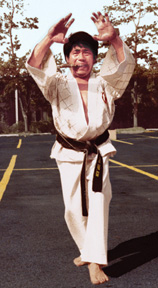by C.M. Griffin & Kyung Sup Kim
(Tae Kwon Do Times, September 1996)
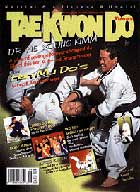 A dwarf becoming a master of Tae Kwon Do? Profile in the highly impossible! Completely unbelievable! This is fodder for those Saturday afternoon movies! Not so. Master Kyung Sup Kim is quite real. He overcame a serious handicap to become one of the leading exponents of Tae Kwon Do in Korea and one of the finest instructors in the World Tae Kwon Do Federation Headquarters: the Ji Do Kwan. Master Kim is the oldest of six children. His father was a police official and the local boxing, Kendo and Judo instructor; his mother was a successful business woman. His family life was very strict, but very loving. He was a happy child without a care in the world. However, one warm summer night, when he was about three-years-old, an event happened which would completely alter his life: “I was playing outside of my grandmother’s house…Now in those days, the houses had ditches built under them, sometimes as deep as ten feet; in order to hide from the Japanese. It was dark and I had the misfortune of falling into one near her house. “The child landed on his head and neck. Miraculously he was not killed. His grandmother heard the child’s yells and somehow she managed to get him out of the ten foot hole. Now the woman was extremely nervous and upset. She was supposed to be watching him to make sure he didn’t go near those ditches. She cleaned the boy and since he appeared to be fine.
A dwarf becoming a master of Tae Kwon Do? Profile in the highly impossible! Completely unbelievable! This is fodder for those Saturday afternoon movies! Not so. Master Kyung Sup Kim is quite real. He overcame a serious handicap to become one of the leading exponents of Tae Kwon Do in Korea and one of the finest instructors in the World Tae Kwon Do Federation Headquarters: the Ji Do Kwan. Master Kim is the oldest of six children. His father was a police official and the local boxing, Kendo and Judo instructor; his mother was a successful business woman. His family life was very strict, but very loving. He was a happy child without a care in the world. However, one warm summer night, when he was about three-years-old, an event happened which would completely alter his life: “I was playing outside of my grandmother’s house…Now in those days, the houses had ditches built under them, sometimes as deep as ten feet; in order to hide from the Japanese. It was dark and I had the misfortune of falling into one near her house. “The child landed on his head and neck. Miraculously he was not killed. His grandmother heard the child’s yells and somehow she managed to get him out of the ten foot hole. Now the woman was extremely nervous and upset. She was supposed to be watching him to make sure he didn’t go near those ditches. She cleaned the boy and since he appeared to be fine. 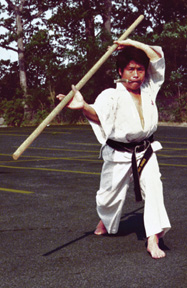 They decided to make that incident their little secret. So he did not tell his parents about the incident. They did not have any inkling that this would be the catalyst to bring down years of pain and misery on the child. Some time had passed, days maybe, before the young boy was awakened by intense pains in his limbs. He found that he could barely move, much less walk without suffering terrible pain. “My muscles felt strange. My spine had twisted in the fall and so my body twisted into an unbalanced awkward position. I could barely walk without flames of agony shooting through my body. My parents sobbed when they saw my deformed posture.”
They decided to make that incident their little secret. So he did not tell his parents about the incident. They did not have any inkling that this would be the catalyst to bring down years of pain and misery on the child. Some time had passed, days maybe, before the young boy was awakened by intense pains in his limbs. He found that he could barely move, much less walk without suffering terrible pain. “My muscles felt strange. My spine had twisted in the fall and so my body twisted into an unbalanced awkward position. I could barely walk without flames of agony shooting through my body. My parents sobbed when they saw my deformed posture.”
Over the next few years they took the child to a number of doctors, hospital and even herbologists: “They all tested and examined me which (the prodding and poking with needles) added to my pain! None of them could find the exact cause of my deformation.” The Korean war broke out and the search for doctors and hospitals had to stop. When the war was over, the children returned to their normal routine of going to school. This too was a special experience for the young boy. “I remember all too clearly those painful (times) as if it were just the other day. My brother had to carry my bag and sometimes…he had to carry me! My limbs would not carry my weight and often the slightest movement would rack my body with agony.”
But the physical agony was only a part of it: “The days the months went by, my doubts and despair grew heavier like a thick black cloud! I had to endure the pain of not being able to perform the simplest of functions such as walking. (I also) had to endure the pain of being the object of cruelties thrown at me by other children!” Because he was deformed and needed special attention, the children ridiculed and humiliated him. He was the target of their harsh jokes and cruel songs. Those were very dark days for the young boy. With the war over, some of his relatives got together with his parents and managed to send him to Seoul University Hospital, the finest and most modern hospital in Korea at that time. At first the boy did not want to go. The thought of more painful tests and examinations on top of what he was already going through was a bit much for him. However, Kim realized the sacrifices his family was making just for him. He decided not to continue arguing with them and entered the hospital. After the examinations the doctors informed the family that if they operated on him there would be a 50-50 chance he would not survive. But if the operations were successful, there would be an end to his constant pain and with therapy, he could lead a normal life. They agreed to take the chance. The operations were successful. “My spine was no longer twisted, I could finally move, I could finally walk without assistance. I could finally walk without pain! For the first time (in my life) I was able to appreciate (the beauty) of the world! I could enjoy life! The world seemed to belong to me!” After his release from the hospital, young Kim thought all his problems were over. After all, he could now walk, move even run. He could experience life without the shadow of constant physical pain. However, as it turned out, that was only a part of the problem. Kim did not grow like the other children. Once again, he was the source of ridicule. “And even my own friends joined in…” As he got older his body did not. His emotional pain became almost as great as his physical pain had been. “Why did I have to live so unhappily, with people constantly pointing their fingers at me, laughing at me, mocking me! (So many times) I cried heavily and quietly. “Everyone has their limits, and young Kim had finally reached his. He often got into fights. He could just barely walk and he was so much smaller than everyone else. The outcome of those fights was absolutely never in question, Kim would loose. Little by little he began to withdraw into himself. “I wished I could prove myself to the world! But all that humiliation eventually turned out to be (a great motivation for me to get my) education and (to strengthen) my body and my mind.”
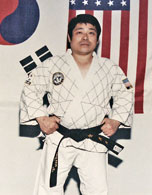 Kim was already training in a manner of speaking. Between his first and second operation, Kim’s father would oversee his physical therapy. After the second operation his therapy included weight training, jogging, jumping rope, and judo. All of this was under the watchful and protective eye of his father. But he felt that he needed more. After long deliberations with himself, Kim decided to train in the martial arts. He went to the local gym and presented himself to Headmaster Lee Byung Ro, and asked if he could train. “Master Lee’s face lit up with a kind smile and told me that if I am so determined, than no handicap can be a handicap. “The young boy felt a fire surge through him, a life, a renewed spirit. There was something special in this gym. Under Lee Byung Ro’s master, Grandmaster Jong Woo Lee, that gym was to become the Jido Kwan. Kim registered, got his dobok, and walked onto the training floor. Suddenly doubt pierced him again as he watched the others go the drills. To him they were all powerful looking, possessing perfect bodies and executing flawless techniques. He felt self-conscious about his ridiculous physique and debated if he should turn around and leave. Fortunately, one of the instructors noticed him standing there, holding his uniform. The instructor yelled, ordering him to change into the dobok and get onto the floor. “At this, I pulled my courage and followed him without the slightest hesitation. “Training in Korea in those days was very different from training today. The beginner students could possibly spend months just doing chores such as cleaning the floor on your hands and knees “for mental strength.” Kim would do his chores, watching the advanced students train and later, at home, he would try to emulate them. Those first days were very difficult. Though he went through an intense physical therapy, this was very different. He had to learn how to maneuver his limbs that had been stiffened by so many years of pain and inactivity.
Kim was already training in a manner of speaking. Between his first and second operation, Kim’s father would oversee his physical therapy. After the second operation his therapy included weight training, jogging, jumping rope, and judo. All of this was under the watchful and protective eye of his father. But he felt that he needed more. After long deliberations with himself, Kim decided to train in the martial arts. He went to the local gym and presented himself to Headmaster Lee Byung Ro, and asked if he could train. “Master Lee’s face lit up with a kind smile and told me that if I am so determined, than no handicap can be a handicap. “The young boy felt a fire surge through him, a life, a renewed spirit. There was something special in this gym. Under Lee Byung Ro’s master, Grandmaster Jong Woo Lee, that gym was to become the Jido Kwan. Kim registered, got his dobok, and walked onto the training floor. Suddenly doubt pierced him again as he watched the others go the drills. To him they were all powerful looking, possessing perfect bodies and executing flawless techniques. He felt self-conscious about his ridiculous physique and debated if he should turn around and leave. Fortunately, one of the instructors noticed him standing there, holding his uniform. The instructor yelled, ordering him to change into the dobok and get onto the floor. “At this, I pulled my courage and followed him without the slightest hesitation. “Training in Korea in those days was very different from training today. The beginner students could possibly spend months just doing chores such as cleaning the floor on your hands and knees “for mental strength.” Kim would do his chores, watching the advanced students train and later, at home, he would try to emulate them. Those first days were very difficult. Though he went through an intense physical therapy, this was very different. He had to learn how to maneuver his limbs that had been stiffened by so many years of pain and inactivity. 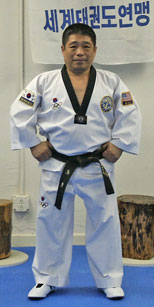 The training was quite painful for him. But with a fire and determination few of us will ever hope to comprehend, the young man continued with his training. “As soon as I finished with (academic) classes, I ran to the gym and devoted all my energy and concentration on following (my) Tae Kwon Do instructors. “Kim had just received his yellow belt when an instructor told him that he would probably quit before he received his blue belt. This hurt him very much. The old angers and frustrations began to swell once again. He felt as if he were going to explode. But he calmed himself. This may not have been “blind prejudice” because of his deformity; there may be some validity to those words. To say that those words added more fuel to Kim’s fire of determination and persistence would be an understatement. He trained even harder. After finishing his school work, he practiced Tae Kwon Do until about two in the morning. With his deformed body, Kim knew he had to run harder and longer, lift more weights; wake up earlier and train harder than anyone else. He would even stay after training and listen to the instructors tell their stories, hoping to pick up some more training tips.
The training was quite painful for him. But with a fire and determination few of us will ever hope to comprehend, the young man continued with his training. “As soon as I finished with (academic) classes, I ran to the gym and devoted all my energy and concentration on following (my) Tae Kwon Do instructors. “Kim had just received his yellow belt when an instructor told him that he would probably quit before he received his blue belt. This hurt him very much. The old angers and frustrations began to swell once again. He felt as if he were going to explode. But he calmed himself. This may not have been “blind prejudice” because of his deformity; there may be some validity to those words. To say that those words added more fuel to Kim’s fire of determination and persistence would be an understatement. He trained even harder. After finishing his school work, he practiced Tae Kwon Do until about two in the morning. With his deformed body, Kim knew he had to run harder and longer, lift more weights; wake up earlier and train harder than anyone else. He would even stay after training and listen to the instructors tell their stories, hoping to pick up some more training tips.
He trained throughout the year; the weather did not stop him. Often during the winter, he would get frost bite from training in his bare feet on the unheated floor. During the summer he would practically be washed in sweat. So much sweat that after training he would have to mop the floors. Kim trained and trained and trained. Whenever he felt as though he would collapse the instructors would encourage him, telling him to “Keep doing what he was doing.” As he started to advance, the senior students would challenge him: “A challenge was when a higher belt would select to train with a lower belt. This training would often look like full contact matches… Tae Kwon Do at this time was not a sport. It was a martial art. “In those challenges he was often beaten badly and even knocked out: “I got broken fingers, (hurt) my legs… Many times I was rushed to the doctor’s house in emergency which would send my family into panic! My mother pleaded with me to stop training. But I couldn’t. I could not possibly allow (defeat) to my only hope (a future in Tae Kwon Do)!” Finally after years of sweat, sacrifice and blood, Kyung Sup Kim received his black belt.”The feeling of contentment and pleasure was beyond words. I felt as if I were walking on clouds. I began to see daybreak and a wide road to my future. However, I didn’t slow down my training. I wanted to set a good example to the new students. I wanted to perfect my skills… and my image as an accomplished (black belt) with continuous exercise and training. I closely watched my seniors perfect their skills and their techniques. I kept repeating their movements over and over again, until I reached their level of grace and perfection. 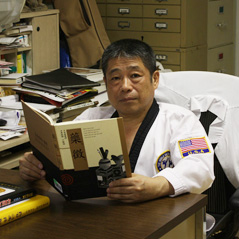 If it wasn’t (accomplished) in days, I did it in weeks; if not weeks, than I did it in months. Before I knew it, I was given the (grade) of master!” While Master Kim was training, his efforts were far from being unnoticed. Stories about his courage and determination spread throughout Korea. When he received his black belt it got attention. Kyung Sup Kim, virtually, was the equivalent of a Korean Helen Keller; having overcome tremendous odds and traumatic experiences by sheer will and determination. Master Kim was a Judge for the World Tae Kwon Do Federation (WTF) tournaments and the chief instructor for the new forms. He would teach, then test all WTF members who wanted to teach outside Korea, insuring that they were all doing the same forms and techniques. He was also responsible for teaching the Taeguk forms. Master Kim came to Syracuse, New York, in 1978 and worked his way down state to New York City where he owns and operates the SMS Tae Kwon Do School. If you observe him teaching a class or even walking down the street, it is easy to forget his deformity. He is short in height, but with his inner strength, his warmth and love for his students and Tae Kwon Do; you feel as if you are walking with a giant.
If it wasn’t (accomplished) in days, I did it in weeks; if not weeks, than I did it in months. Before I knew it, I was given the (grade) of master!” While Master Kim was training, his efforts were far from being unnoticed. Stories about his courage and determination spread throughout Korea. When he received his black belt it got attention. Kyung Sup Kim, virtually, was the equivalent of a Korean Helen Keller; having overcome tremendous odds and traumatic experiences by sheer will and determination. Master Kim was a Judge for the World Tae Kwon Do Federation (WTF) tournaments and the chief instructor for the new forms. He would teach, then test all WTF members who wanted to teach outside Korea, insuring that they were all doing the same forms and techniques. He was also responsible for teaching the Taeguk forms. Master Kim came to Syracuse, New York, in 1978 and worked his way down state to New York City where he owns and operates the SMS Tae Kwon Do School. If you observe him teaching a class or even walking down the street, it is easy to forget his deformity. He is short in height, but with his inner strength, his warmth and love for his students and Tae Kwon Do; you feel as if you are walking with a giant.
